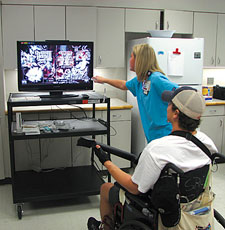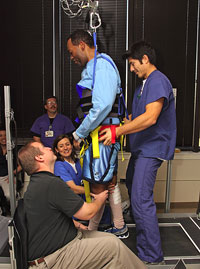New Tools Offer Rehabilitation Options
By Caperton Gillett
 |
A therapist works with a patient on mobility exercises using the Nintendo Wii gaming system. |
Most patients would be elated if their doctors prescribed a few hours of video games. But for patients with brain and spinal cord injuries at UAB Spain Rehabilitation Center, therapy using the Nintendo Wii gaming system is no joke.
The concept of “Wii-hab” originated with physical therapists and physicians looking for ways to encourage patients to get active and to help people with disabilities regain independence. The Wii’s innovative, motion-sensing control mechanisms and physically demanding games involve a wider range of movements and activities than other video game systems. “The technology gives patients an idea of what they can do instead of what they can’t,” says Phil Klebine, project coordinator for the Dr. Samuel L. Stover Assistive Technology Lab, located in UAB’s Center for Psychiatric Medicine.
Relearning Living
The Wii is only one tool in the lab. Primarily funded by a grant from the Christopher and Dana Reeve Paralysis Foundation, the lab offers nearly every device available to help patients with limited mobility learn to become more independent and make efficient use of their efforts in their daily lives.
“People with spinal cord injuries frequently arrive with a lot of preconceptions about what they can and cannot do,” Klebine says. “When they get into the tech lab, they discover, ‘I can play Wii. This is kind of fun. Let me try this computer.’ And they learn to use a computer with voice recognition, a trackball, T-bars, or foot pedals, and then they start thinking ahead. ‘What else can I do at home, work, or school?’ The best part of the lab is that they can get hands-on experience with technology to enhance their daily independence.”
 |
Patients relearn the natural motions of walking with the TheraStride system, which supports their weight while therapists guide hip and leg movements. |
Great Strides
Physical therapy patients also use the Wii to regain strength and control by simulating activities they already enjoy. Amie Jackson, M.D., chair of the UAB Department of Physical Medicine and Rehabilitation and the Robert B. Kyle Professor and Chair in Rehabilitation Medicine, recalls a patient with quadriplegia who regained the ability to play ping-pong by using the system to exercise his muscles. It’s an “incredible” solution for building strength “without taking patients outside to do something they may not be ready for,” she says. “And it’s something they love that their brain already knows how to do.”
Physical therapist Cathy Carver identifies the technique as “Activity-Based Therapy.” In other words, “if you want to learn to walk, you walk. If you want to learn to balance, you do a balance activity,” she says. Doing exercises without the context “isn’t the same activity.”
Similarly, another new piece of assistive technology at UAB, the TheraStride system, helps patients regain mobility by supporting them through the natural motions of walking—but without the fear of falling or the use of rails or canes that could change a person’s gait. The treadmill-based system includes a harness that can support up to 60 percent of a patient’s body weight; its design also allows physical therapists to guide the hips and legs through correct movements.
“Our goal is to get patients up to normal walking speed with step patterns as close to normal as possible,” Carver says. “We gradually work down the body-weight percentage, work up the speed, and work down the level of assistance. Then we train off the treadmill to see carryover.”
Freedom and Independence
The impact of assistive technology is psychological as well as physiological. “People don’t get as frustrated or discouraged, because they see things happening faster,” Jackson says. “That keeps them in therapy, and then they reach their goals faster.” Carver has seen patients become able to move from their beds to wheelchairs or get into a bathtub—or get out of the house—unassisted.
“Independence is not necessarily the ability to do something,” Klebine adds. ‘Independence is about being in control of one’s life and environments, and that’s what this technology offers."
